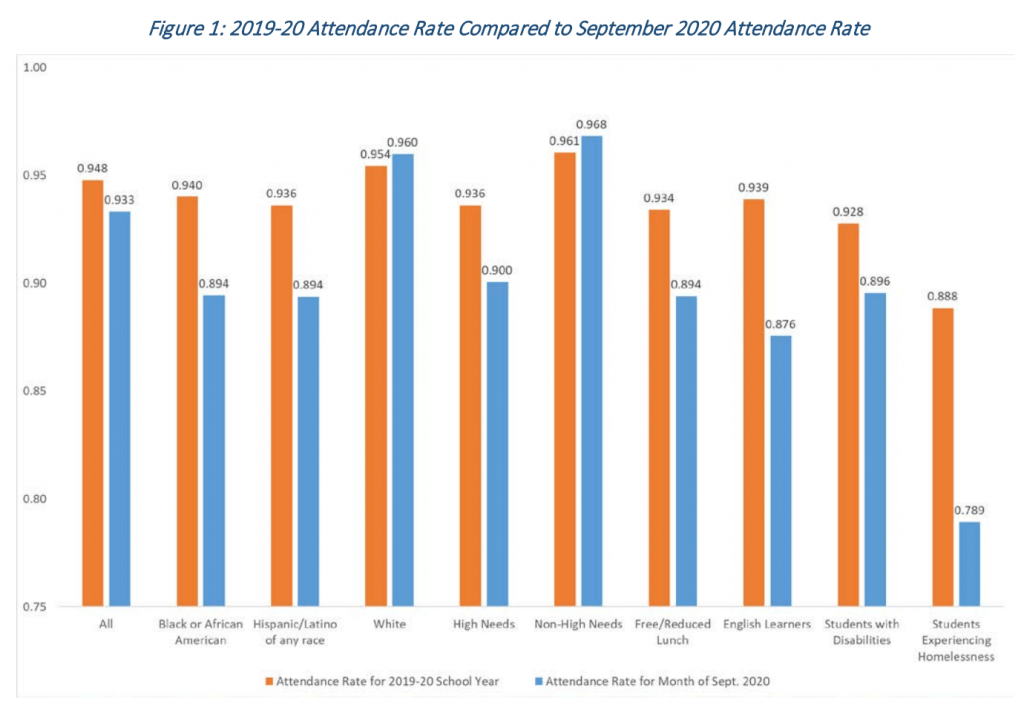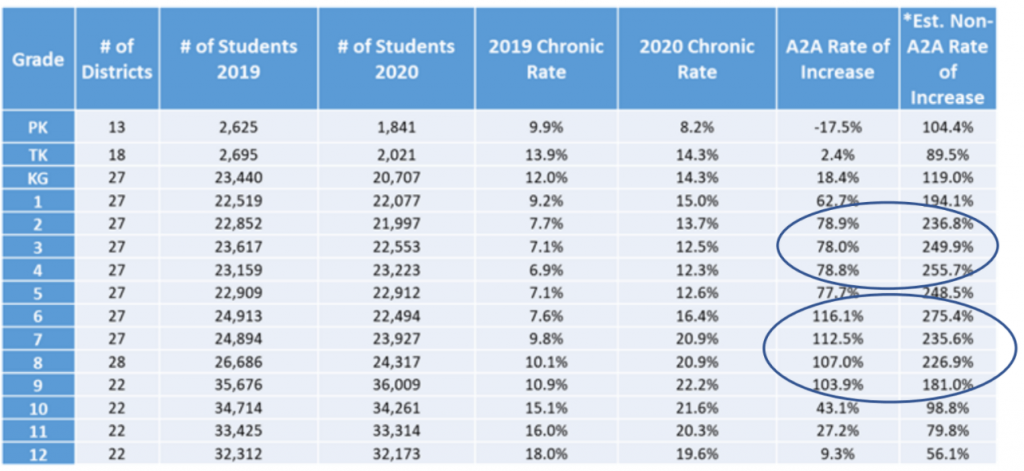Two weeks ago, we wrote about the critical importance of monitoring attendance data during the first weeks of school. Today we are pleased and impressed with efforts taken by Connecticut and California to analyze and publicly share attendance data so it can be used by educators and policymakers to take timely and necessary action. The data is alarming, and is a call to action for policies that protect and support our nation’s schools.
As a result of challenges brought on by Covid-19, the Connecticut State Department of Education (CSDE) took the unusual step of collecting monthly attendance data, and regularly releasing it to the public. The data included key information about enrollment and modes of instruction.
Education Commissioner Miguel Cardona said the state decided to gather and release attendance data to help them identify patterns early on around issues with attendance and participation, especially for the state’s most vulnerable populations. “Using these data to pinpoint areas of greatest need, we will proactively work with educators, families, and community partners to address the root causes of that absenteeism and disengagement by establishing systems of support to reach all of our students,” Cardona said.
CSDE’s data recognizes that shining a light on inequalities and areas of need in a timely manner is a critical strategy for mobilizing key stakeholders to take action. Although the state is still working on the release of chronic absence data, this initial release offers compelling insights into the challenges facing schools and communities in today’s everchanging school year. See Figure 1 below.
CSDE’s data call attention to troubling trends including:
- A 3% decline in enrollment, that reflects delays in school entry among the youngest learners and an increase in homeschooling.
- Substantially lower levels of attendance among vulnerable student populations including Black and Hispanic/Latinx students, English Language Learners, students with high needs and disabilities, and those living in poverty and experiencing homelessness.
To make the data even more actionable, CSDE released downloadable data tables with information broken out by school and district, and called for districts to take an even more consistent approach to taking attendance.
In California, an analysis of 33 school districts conducted by School Innovations and Achievement (SI&A) at the request of the California Department of Education also shows what can be learned from chronic absence data. The findings, first shared in a webinar including Attendance Works, show that chronic absence rates in California are increasing at an alarming pace.
The numbers show that chronic absence increases are higher in the elementary grades, especially grades 2-4, while in the middle school years, (grades 6-9), absence levels are especially large. See table below.
While SI&A’s analysis doesn’t show substantial increases among the very youngest learners (students in preschool, transitional kindergarten and kindergarten), this should not be interpreted as a sign that learning loss is not occurring, since these are the grades most affected by declining enrollment. Because districts working with SI&A typically have better attendance, the analysis projects even higher rates of absenteeism throughout the state.
California’s data also reveal that students of color are disproportionately affected. Among the districts studied, chronic absence rates nearly doubled for Hispanic/Latinx and African American students, with increases from 11.5 – 19.5% and 16.2 to 29.2 % respectively. Among Native American youth, rates rose from 15.2 to 24.3%. These are also the same populations most challenged by chronic absence prior to Covid-19.
These findings are a call to action for federal and state policy makers to protect and enhance funding in public education. Local, state and national policies must help schools and communities take targeted and strategic action. New policies should reflect a commitment to:
- Invest in data quality and research.
- Target supports for students most adversely impacted by the coronavirus pandemic.
- Identify and invest in promising practices for reengagement and recovery.
- Include input from the students and families living in communities most impacted by the pandemic, when identifying the causes for student absences and developing meaningful solutions.
These emerging data from Connecticut and California clearly illustrate that the education equity gap, intensified by the pandemic, is quickly becoming an equity chasm. We can move now to mitigate the learning losses laid bare and exacerbated by Covid-19. Narrowing the chasm requires taking a long-term approach that starts with strategic and targeted action that begins right now.
Download Connecticut’s reports, Student Attendance in September 2020, and An Analysis of Preliminary Public School Enrollment in 2020-21.
Download SI&A’s report, Preliminary Chronic Absence Patterns & Trends Analysis

